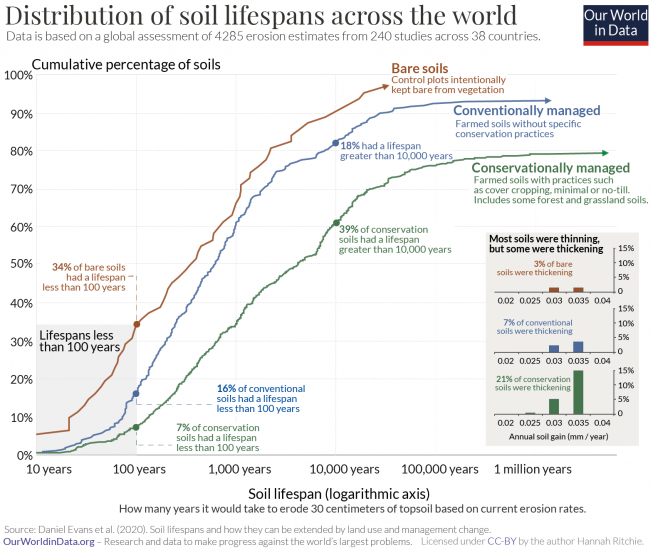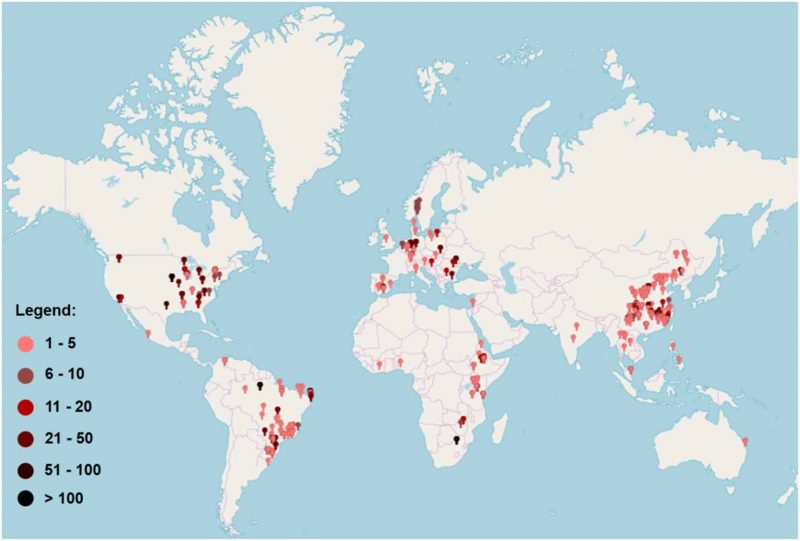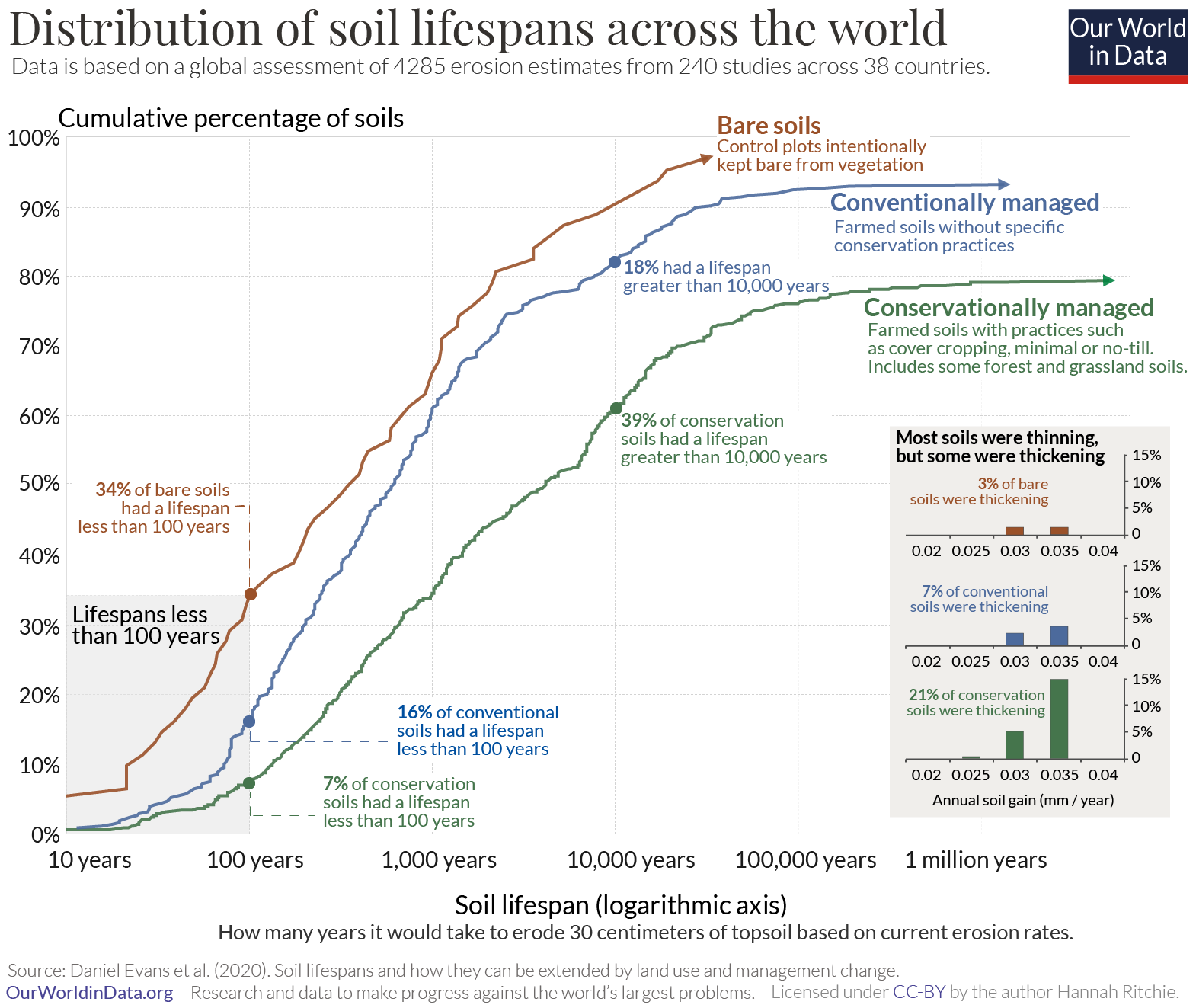Acknowledgements: Many thanks to Dr Daniel Evans for providing feedback and inputs on this article.
Summary
The stark claim that the world has only 100; 60 or even 30 years of harvests left often hits the headlines. Although they continue to be repeated, there is no scientific basis to them. While the claims are overblown, soil erosion is an important problem. Erosion rates from across the world span five orders of magnitude. Some are eroding quickly: 16% of soils are estimated to have a lifespan of less than 100 years. Others are eroding slowly: half have a lifespan greater than 1000 years; and one-third have over 5000 years. To protect our soils we must adopt better agricultural practices – such as cover cropping, minimal or no tillage, and contour cultivation. This way we can extend the lifespan of the soils that we all depend on.

If one reads the newspaper headlines on the state of the world’s soils it is easy to be convinced that we are only decades away from global famine:
- “The world’s top soil could be gone within 60 years” says a senior UN official;
- “Britain has only 100 harvests left” writes the Independent newspaper;
- “UK is 30 to 40 years away from the ‘eradication of soil fertility’ warns Gove” [the former Environment Secretary].
The good news is that these claims are overblown. The bad news is that this doesn’t stop them being repeated over and over. The “60 harvests left” statistic seems to be one that just won’t die.
And while the headlines are exaggerations it shouldn’t take away from the fact that many of our soils are degrading and we need to take action to restore them.
Where do these claims come from?
The honest answer is that we don’t know. Botanist and science communicator, James Wong, tried to trace these claims back to their roots for an article in the New Scientist.1 We know that a senior official at a UN FAO farming conference was quoted with the “60 harvests” figure and that Michael Gove mentioned a 30 to 40 year deadline. But we don’t know what they based their assessments on.
The “100 harvests” figure seems to link back to a study in the UK conducted by researchers at the University of Sheffield.2 I say “seems to” because there appears to be no mention of the 100-year figure in the paper. James Wong failed to find where this number came from; I also spent a lot of time digging and did no better.
In any case, this study looked at the difference in soils properties of city allotments in Leicester, a city in the UK, and soils from some surrounding farms. It concluded that the soils in city allotments had more organic matter, higher nitrogen levels and a better soil density. Not exactly informative for the larger and more urgent question on the state of the world’s soils.
There is no single lifespan of the world’s soils
What do we know about the state of the world’s soils?
A recent study by Daniel Evans and colleagues gave us a first assessment of the range of soil lifespans across the world.3 This drew upon a database of 4285 measured soil erosion rates, from 240 studies, covering 255 unique locations across 38 countries. As shown in the map, these 255 locations span all continents of the world.
How would we estimate the ‘lifespan’ of a soil? There is no single metric to do so: soils are complex and have a range of properties from nutrient balance, to density, and structure. The best proxy – and the metric that Daniel Evans and his colleagues used – was net erosion rates of the crucial topsoil layer, the topmost layer that is around 30 centimeters thick [in reality, this thickness varies from soil to soil, but 0.3m is the most commonly adopted figure for this upper productive layer]. Crops need this layer to grow: it’s where the carbon, water and nutrients get stored.4
Depending on how the soil is managed, this topsoil can thin or thicken. If we know what rate it’s thinning, we can estimate how long it would take for this layer to disappear. For example, if a topsoil was thinning by 0.5 centimeters every year, it would take 60 years to lose 30 centimeters.5 If you want a more detailed understanding of soil lifespans and how they’re calculated, the lead author explains this here.
It’s not the only metric that determines soil productivity, but it’s a meaningful metric that tells us something valuable about the state of the world’s soils.

The lifespans of the world’s soils span five orders of magnitude
What did this study tell us about the lifespan of our soils?
Soils from the 4285 data points in the study were grouped into three categories.
‘Bare’ soils are plots of land which are deliberately kept free from any crops to determine erosion rates of soils without vegetation. These are used to assess a ‘worst-case scenario’.
Conventionally managed soils are those which are actively farmed, without implementing notable conservation practices. These are used to represent a ‘business-as-usual scenario’.
Conservation management soils were those that had been subject to soil conservation techniques such as land use change (to forests and grasslands) or improved agricultural practices such as intercropping, no-tillage, or contour farming. We will look at the impact of these techniques later.
In the chart here we see how the distribution of estimated soil lifespans in these three categories varied across the global dataset. On the x-axis we have the lifespan in years and on the y-axis we have the cumulative percentage of soils that were found to have that lifespan. Notice that the scale on the lifespan axis is logarithmic and stretches from 10 years to 10 million years. This further demonstrates how citing a single lifespan for the world’s soils is inaccurate and nonsensical.
Let’s focus on the ‘conventionally managed’ soils, shown in blue. These data are relevant for understanding many of the world’s farming practices. We will look at conservation techniques later.
Many of these soils are thinning; some very quickly. 16% have a lifespan of less than 100 years if they continue to erode at their current rates. This is not a local problem: there are examples of soils with lifespans shorter than a century on all continents, including the United States, Australia, Spain, Italy, Brazil and China. The longevity of these soils is concerning and we should be acting quickly to preserve them.
But the “60 harvests” claim is quite clearly false. More than 90% of conventionally managed soils had a ‘lifespan’ greater than 60 years. The median was 491 years for thinning soils. Half had a lifespan greater than 1,000 years, and 18% exceeded 10,000 years. There were also some soils that were not eroding at all. Where soil formation rates exceeded erosion rates, soils thickened.In fact, some were thickening – soil was forming quicker than it was eroding. In the bottom-right of the chart we see the rates of soil gain. 7% of conventionally managed soils were thickening.
If we were to keep our land completely bare – by removing any vegetation and preventing any natural regrowth through pesticides – our soils could erode more quickly. One-third (34%) of bare soils had lifespans less than 100 years.
There is no single figure for how many harvests the world has left because there is so much variation in the types, quality, and management of our soils. It’s just implausible that they would all be degrading at exactly the same rate. As these results show: some soils are eroding quickly while others are thickening.
What can we do to slow erosion and restore our soils?
It’s concerning that so many of our soils are thinning. Some, very quickly.
But, there are things we can do to extend the lifespan of our soils. Take a look at the ‘conservation’ curve in the previous chart. It’s shifted far to the right – even more so because the lifespan scale is logarithmic – meaning these soils are eroding much more slowly than conventionally managed soils, if at all. In fact, one-fifth were actually thickening (meaning soil was forming faster than it was eroding).
A comparison of these two groups is shown in the table. The share that had a lifespan less than 100 years was less than half that of conventionally-managed soils – 7% versus 16%. Half of the soils managed with conservation management had a lifespan greater than 5000 years; and 40% exceeded 10,000 years.
This sounds promising, but what does ‘conservation’ actually mean? What practices should we put in place? There are four interventions we should consider according to Evans et al.7
We could switch from agricultural land use to forest or grassland. This is the most effective way to extend soil lifespans, but it reduces the land available for farming. As the global population increases, and demands for food rise, we need to find ways of protecting our cultivable soils. If we can increase crop yields we have the opportunity to reduce the amount of arable land we need to meet this demand.
We can plant cover crops during the non-harvesting season. If we need to use our land for farming, cover cropping can be effective in improving soil quality. None of the plots that used cover cropping in the study had a lifespan of less than 100 years.
This is a practice that involves growing a crop for the purpose of maintaining a vegetative cover and preventing soils from becoming bare and susceptible to erosion between growing seasons.
We know from our comparisons above that ‘bare’ soils erode much more quickly. To prevent this, you can plant a cover crop during the off-season, which maintains soil structure, fertility and enhances organic matter.
Cover crops consist of leguminous plants such as peas, beans and lentils. Cover cropping has been shown to be effective in reducing soil erosion.8, 9,10
We can use minimal or zero tillage practices. Conventional ‘tillage’ is a common practice where farmers will mechanically agitate and overturn the soil using ploughs.
This is done to mechanically dislodge and destroy weeds; aerate the top layer of soil, and mix the nutrients evenly throughout the soil profile.
But this also creates negative impacts: it can damage the soil structure, leading to soils becoming more susceptible to erosion. Increasing soil erosion can lead to a loss of nutrients and organic matter; it may increase chemical run-off from the land; and may reduce water infiltration.
Minimal or zero-tillage practices try to manage soils without this mechanical overturning of the soil. This reduces soil erosion but has its own trade-offs: because weeds are not disturbed by ploughing, it often requires more herbicides to kill them. Some of these trade-offs can be reduced by combining it with cover cropping. Cover crops such as legumes add nitrogen to the soil, and can protect the soil from weeds and pests.
We can implement contour cultivation or terracing on hillslopes. The gradient of the land makes a big difference to the susceptibility of the soil to erosion. Soils on a steep slope erode much more quickly. 37% of soils which were cultivated up-and-down the slope had a lifespan less than 100 years. Contour cultivation – where you grow crops perpendicular to or across the slope – reduced this to 7%.
Contour cultivation is not always practical on very steep gradients. In this case, terracing can be effective. Only 2% of terraced plots had a lifespan less than 100 years. The downside to terracing is that it can reduce the amount of land you have available to grow crops. In some cases the benefits of reduced soil erosion, and improved water and nutrient management will outweigh this cost.
The agricultural practices that are most effective will be location-specific. They will depend not only on the environmental qualities of the land, but also on the social and economic constraints of the farmer. There’s no universal solution, but it is clear that there are plenty of opportunities to increase the lifespans of soils across the world.
| Soil management | % with lifespan less than 100 years | % with lifespan greater than 5000 years | % with lifespan greater than 10,000 years |
| Conventional | 16% | 23% | 18% |
| Conservation | 7% | 48% | 39% |
Extreme headlines could do more harm than good
People will often argue that while extreme headlines may be untruthful, they are worth it if they force people to take action. I don’t buy it. It can be damaging in many ways.
Firstly, it forces some people towards solutions that are ineffective or counterproductive. Some blame the decline in soil fertility on the use of fertilizers and other chemical inputs. The “60 harvests” claim from the UN senior official has been used many times to argue for a switch to organic farming systems [here is it being used at a UN International Year of Soil conference]. Michael Gove said the UK had only 30 to 40 years of harvests left because it was “drenching them with chemicals”. But many of the conservation techniques have nothing to do with organic farming. In fact, shifting to a no-tillage approach often requires more pesticides and fertilizers, not less. Since average yields tend to be lower in organic farming, it requires more agricultural land. This is in obvious conflict with the best way to reduce soil erosion: have as little cropland as possible. In some contexts organic farming can play a role, but it’s not the ultimate solution. Misleading headlines convince people that it is.
Exaggeration also creates the opposite problem: apathy. Many people don’t take it seriously and dismiss that there’s any problem. The headlines might be overblown, but this shouldn’t detract from the fact that soil erosion is a serious problem. It’s one we can’t afford to ignore and as I have shown it is a problem that we can do something against.


